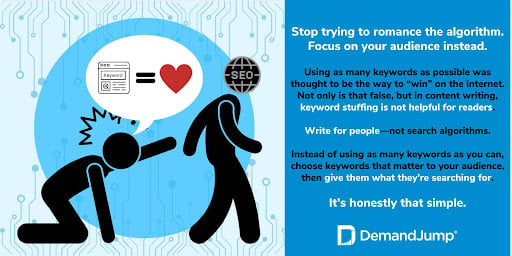What Is Bad SEO?
June 12, 2023 •Devin Dabney

If you’ve been searching for information on SEO, you’ve probably found a lot of companies telling you the “right” way to do it, but you usually won’t see examples of the wrong way. This is likely because telling you about the mistakes you may be making doesn’t sell their product, but promoting themselves as the correct answer does. But how can you know how to fix your brand’s SEO strategy if you don’t even know what’s broken?
Asking for SEO help shouldn’t feel like going to a shady mechanic who upsells you by keeping you in the dark. And even when you do find trustworthy experts, digital marketing is more than letting the experts take the wheel (though you should do that on occasion). It will benefit your overall strategy if you can identify bad SEO examples as quickly as good examples. This is especially true because, as you’ll learn, bad SEO is not just about what you’re doing wrong. It’s also about what you may not be doing at all. We at DemandJump want to offer some advice on SEO pitfalls—and how to avoid them.
What Does “Bad SEO” Mean?
There are many things that can be considered bad SEO, and while some of them are accidental, some of them are done with underhanded—or even nefarious—intent. “Bad” SEO usually falls into one of four categories:
- Unconscious mistakes by the content creator
- Outdated SEO practices that are believed to be good choices
- Actively seeking shortcuts in content creation
- Using black hat SEO to cheat search algorithms
As you can see, the question “What is bad for SEO?” poses not only a technical question, but a moral one. There is “bad” SEO in the sense of “poorly done,” and “bad” as in “immoral” (or at the very least, detrimental to internet users). Sometimes, content creators don’t know they’re doing it. Other times, it’s a clear attempt to undercut others. And as technology evolves, this discussion of search engine ethics will only become more complex—especially as AI tools like ChatGPT enter the conversation.
But that conversation is for another time. Today, we’re going to focus on some concrete examples of bad SEO, most of which people do without realizing.

Bad SEO Examples
What defines “bad websites?” That phrase may drum up a specific experience you personally had on a website, and chances are, it included one or more of the following:
- Content that was poor, unhelpful, or unrelated to your search
- Web pages that were slow to load or buggy
- A confusing experience navigating through the site
Indeed, these are all unpleasant, and they do impact SEO. But what about the things that your end users can’t see? There is far more to optimizing your site than what is on the page; in fact, that represents only one category of SEO (known aptly as on-page SEO). Let’s look at some common SEO mistakes:
Keyword Stuffing
While you technically can see keywords, their potential negative effects on SEO are less visible. Early on, using a lot of keywords was thought to be the way to “win” on the internet. But as Google and other search engines update their content guidelines, excessive keyword usage is being punished more frequently—and more severely. Even if this weren’t the case, using a ton of keywords is not helpful to the end user, and will not generate repeat visits.
When it comes to keywords usage, choose quality over quantity: pick keywords that help your target audience find you, and use a variety of different types of SEO keywords, such as short-tail, long-tail, and question keywords.
Unhelpful Content
What is unhelpful content, exactly? It’s content that lures a reader in but doesn’t answer their questions or give them what they want. The operative part of that is luring a reader; after all, how can they know it’s “unhelpful” if they never see it? Most think of clickbait when it comes to unhelpful content, but it also can be a disconnect of communication between the reader and the content creator. This is another common SEO mistake when using keywords: not understanding how people search for content.
Simply grouping a bunch of high-value keywords together doesn’t generate high-value content. You also have to answer the readers’ questions in a way they can understand, with language they can relate to. This is one of the core principles of DemandJump’s Consumer Insights platform, which pulls keywords on chosen topics—keywords that are actively being searched by people in real-time. This should serve as the basis for your content creation, but is by no means the only ingredient. You can use these keywords to guide research and know what questions to answer for your readers.
Technical SEO Errors
We’ve said it before, and we’ll say it again: SEO is complicated. In fact, one type of SEO is so technical, it’s literally called “technical SEO”—and oftentimes, this part of SEO is where websites fall short. There are obvious technical errors like a website not loading right, or a slow buffering time. But many websites simply miss out on SEO by forgetting the little details: forgetting alt text, URLs that confuse search engine crawlers, or images that are too large are just a few examples. All of these types of SEO mistakes can drain valuable SEO juice from your content, hurting your chances straight out the gate.
Don’t forget the little things when it comes to SEO. It’s not always about making stellar content, though that is part of the equation. Sometimes, good SEO is a well-written meta description, an appropriate title, or making your images the right size.

(Demand)Jump Over Common SEO Pitfalls
Many times, you don’t miss the SEO mark from technical execution, or even your content’s quality. It may just be that you’re not speaking in the language that attracts your content’s target consumers. That’s the main focus of Pillar-Based Marketing: DemandJump’s digital marketing strategy that centers around your target audience—and how they search for answers online. With our Insights platform, we’re able to pinpoint exactly what questions people have, and how your content can position your brand as the answer to your consumers’ questions.
If you want to know more about how Pillar-Based Marketing can benefit your brand, please reach out to us, or try it free and see for yourself!
Featured Articles
Categories
- Attribution Tracking (13)
- Channel Optimization (11)
- Consumer Insights (68)
- Content Marketing (251)
- Data Science (8)
- Digital Marketing (6)
- Digital Transformation (26)
- Enterprise (10)
- Lead Generation (14)
- Market Intelligence (8)
- Marketing Analytics (39)
- Marketing Attribution (57)
- Marketing Management (153)
- Marketing Operations (86)
- Organic Search (222)
- Paid Search (52)
- Pillar-Based Marketing (63)
- Programmatic Advertising (9)
- SaaS Content (14)
- SaaS Marketing (29)
- Search Marketing (111)
- SEO Keyword Research (28)
- SEO Pillar (18)
- SEO Strategy (46)
- SMB (5)
- Website Content (12)


